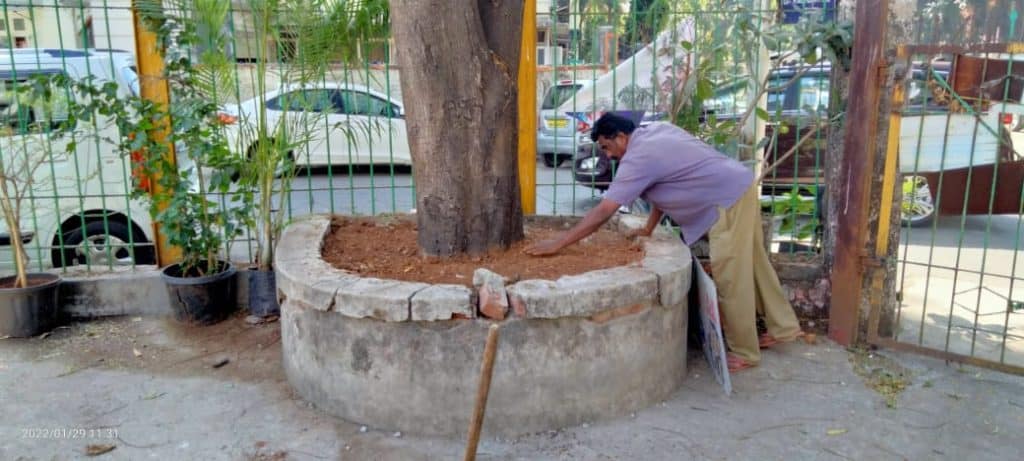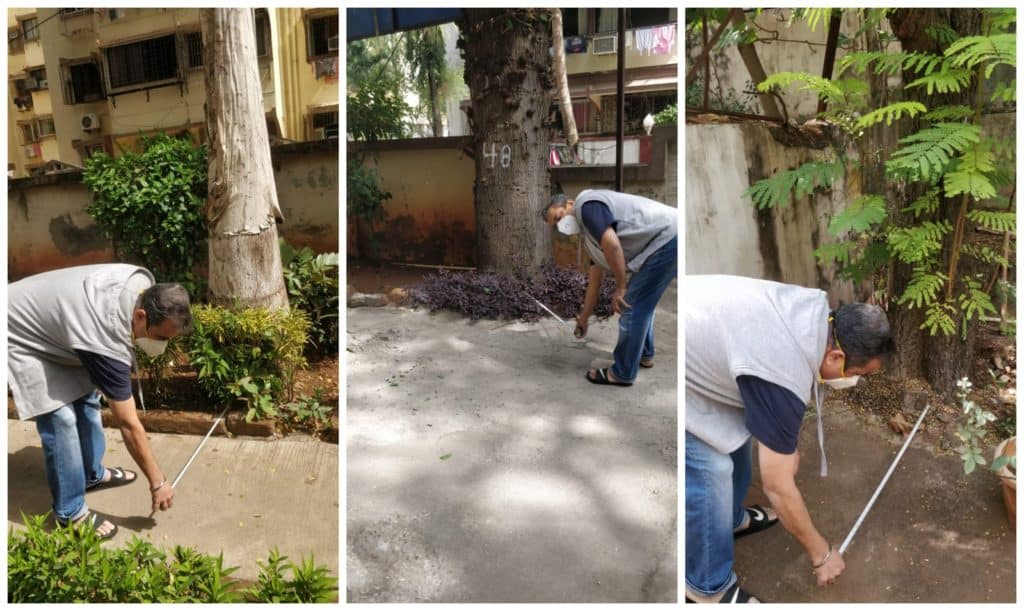When trees in Mumbai are cut, public furore is a typical response, for good reason. But what often goes unnoticed is the concretisation of trees, a practice that results in the same end.
Trees in-between spaces meant for roads, footpaths, and parking, are often engulfed by construction and repair work. The tree floor is left covered under thick impenetrable concrete. This is despite a National Green Tribunal (NGT) ruling to keep a 1-metre radius around a tree, free of concrete and construction.
“I noticed the concretised trees in the open gym at the Bandra Physical Culture Association ground a month ago,” says Dennis, a resident of St. Martins road, Bandra. After finding it unchanged, he tweeted a complaint to the H West ward on January 27, 2022. Two days later, the Brihanmumbai Municipal Corporation (BMC) cleared the surface layer of concrete around the trees and replied with pictures for evidence.
Such action comes to the rescue of trees in Mumbai, where over 130 km of roads were concretised last year. Citizens file their complaints through Twitter, the helpline 1916, or in writing. Subhajit Mukherjee, the founder of the NGO Mission Green Mumbai, fields an average of 10 complaints in a week. He directs most of them towards procedure and leads the others to the BMC.
But it is not always possible for environmentally active citizens to stay alert, and some incidents are overlooked or delayed.
A housing society in Vile Parle complied to 3 complaints only after six months. Re-concretisation, after de-concretisation, left a 10 year old tree in Malad dried out and dead. For the 3,112 trees the Garden department deconcretised in 2020-21, 584 were removed because of their dead or dangerous state.

Enforcement troubles
“There is always a disconnect between the Garden Department and Roads Department,” says Subhajit. “When roads are made, they forget to leave space. In housing societies, people want parking lots, not trees.”
The Garden Department of the BMC is headed by the Superintendent of Gardens and Tree Officer. But each ward’s assistant superintendent of gardens and junior tree officer is responsible for the maintenance of the trees in their ward.
In 2019, the BMC re-issued the NGT’s standing order to road contractors and the vigilance department.
“The tree officer” – Jitendra Pardeshi – “writes multiple letters, but they have no value for the contractor lobby or executive engineer in charge of the road. These departments have no link in common,” says Stalin D, director of the environmental NGO Vanashakti. “It should be mandatory for the contractor to get a certificate from the tree officer that no harm will be done to the trees before the work is allowed.”
Currently, the Garden department is not privy to the initial stages of construction work, neither to supervise or sanction. It is only brought in the later stages, when a complaint or occasional vigilance demands an undoing of the work.
“People do it unknowingly, but once they’re told about the order, they rectify their mistake,” says a junior tree officer in the BMC.
Read more: Is restricting access to public spaces in Mumbai in people’s best interest?
A slow and gradual killing
“Concretisation is like strangling a tree,” says Dr Shashirekha Sureshkumar, a botanist and professor at Mithibai College, and former expert in the Tree Authority. “The concrete layer completely closes off the base, leaving no room for the tree to widen. The roots are blocked from reaching soil and hence, nourishment.”
The committee is the only opportunity to include voices of autonomous experts into the tree policies of the municipality, particularly regarding plantation and felling. Marred by politics, however, the number of experts has dwindled down to one.
Older trees are able to sustain themselves for longer, as their deeper roots can reach distant sources of water and nutrition. “The tree might not die immediately, but ultimately it will,” says Dr Sureshkumar. But the effect on younger trees is immediate, leaves fall off and the tree dries out.
A spate of unexplained rain tree deaths in 2013 had prompted the organisation, Vanashakti, to investigate. An inspection of almost 2,000 trees in Mumbai found that 1,359 of them turned out to be infested with mealy bugs and fungi. The air, water and xx stress due to concretisation had reduced their immunity against infections. “Upon digging in the tree’s vicinity, it was observed that up to 4-5ft of concrete, tar and other construction material constituted the tree’s base,” reads the report by Vanashakti.
But, distinctly, all 143 of the trees in Aarey Colony were undisturbed, as were the majority in Goregaon, Godrej Colony and Nerul due to their forest-like conditions. The tree canopy’s connection to the base – ensuring hydration from dew and rain and nutrition through decomposing leaf litter – create a natural self-subsisting tree basin.
Roadblocks
In the monsoon of 2019, two heritage trees (those 50 years and above) toppled over in Geetanjali CHS, a housing society in Andheri. Years of concretisation had left the roots underdeveloped, unable to support the heft of the tree in the weather.
Two residents, Aarti and Sudhanshu Gupta, then wrote to the Jr. Tree Officer of their ward, demanding deconcretisation.
Two years, few letters and RTI requests later, none of the notices sent to the housing society had led to effective change. On January 19th, 2020, the first appeal hearing for the RTI was held.
“They haven’t done the deconcretisation even partially yet. All they did was break a small area around 4-5 of trees and stand to take pictures. It’s just an eyewash,” says Sudhanshu.

The ward officers of the Garden department only have quasi-judicial powers. They only send notices, not punitive charges, to private spaces and housing societies. Harsh action is very rarely needed, assures the Tree Officer.
“People should be more active in enforcing the NGT order. There have been small wins where concretisation was stopped, like in Dadar. But the BMC has a very bad record when it comes to trees,” says Stalin. “Almost every tree, except the ones in Aarey forest, are buried in concrete. They’ve only made it worse.”